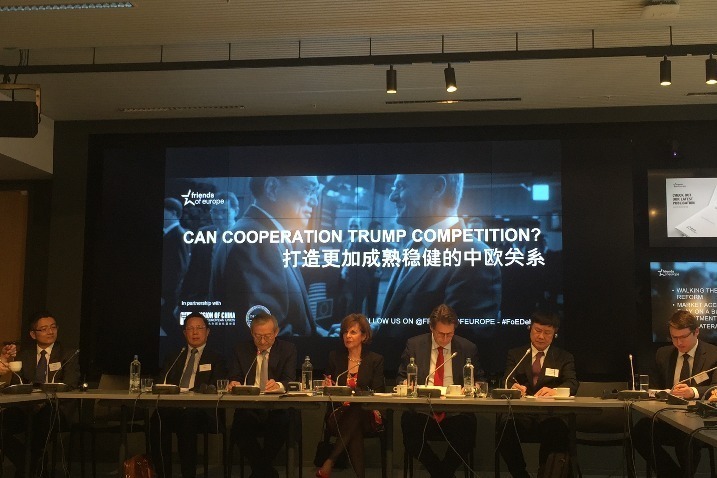Challenges faced by Chinese companies’ innovation-driven development
By Shen Jiawen |
chinawatch.cn |
Updated: 2019-04-02 15:32
Challenges faced by Chinese companies’ innovation-driven development
In 2017 China is ranked the world’s 17th most-innovative economy, rising from the 20th spot in 2012, as the country’s economic strength, investment in science and technology and personnel training are catching up with the advanced nations.
To meet the demands of social and economic development, it is not realistic to depend on imported technology. Instead, focus should be put on the endogenous innovation, in particular, the innovation capability of enterprises.
Chinese government is encouraging a market-oriented innovation nurturing mechanism to synergy efforts from enterprises, higher education, and research institutes, with enterprises, especially small and medium-sized enterprises, being the main players.
In general, there are four challenges standing in the way of Chinese companies’ innovation-driven growth.
To start with, the quality of technology innovation should be improved in key fields that are dominated by developed countries. China’s invention patents applications have been ranked the highest worldwide since 2011, reaching 1.54 million in 2018. However, China's external payments for intellectual property rights (IPR) royalty soared from $1.9 billion in 2001 to $35.6 billion in 2018 with a deficit exceeding $30 billion.
In sharp contrast, the United States has an annual net income of IPR royalty payment of $80 billion.
In terms of core technologies, more than 50 percent are imported, and even over 80 percent for some crucial parts. In 2018, for example, China imported $312 billion worth of integrated circuits (IC) and exported $85 billion worth of IC products, creating a deficit of $227 billion. So it is of imperative significance to increase self-sufficiency ratio of the core technologies.
Second, the role of enterprises as the main players in innovation should be strengthened. Although Chinese companies account for over 70 percent of the total investment on R&D, research personnel and invention patents, only 23 percent of industrial enterprises above the designated size (referring those with annual main business revenue of 20 million yuan or more) have R&D institutes, and only 0.03 percent of them have IPR in core technology.
On the other hand, China ranks world’s second in publishing sci-tech papers, but only 10 percent of these research could be put into production, far lower than the rate of 40 percent in developed countries. A large amount of R&D results have no practical use; only 5 percent of patented technologies are traded and less than 5 percent of them are commercialized. So, synergy should be created through the joint efforts of enterprises, universities and research institutes, which needs reforming China’s current science and technology system.
Also, the overall efficiency of Chinese enterprises’ innovation system should be improved. Only seven Chinese companies made it onto the Forbes 2018 list of the world’s 100 most innovative companies, while the US topped the chart with 51 companies.
With these caveats, Chinese companies should improve the efficiency of their innovation system by concentrating the limited innovation resources and enhancing commercialization ratio of R&D results.
From this perspective, a group of innovation-focused entrepreneurs should be vigorously cultivated.
Over the past few years, an array of innovative startups have emerged in China, including some with global influence in sectors such as smart terminals, drones, e-commerce and artificial intelligence.
However, In the 2017 BrandZ Top 100 Most Valuable Global Brands ranking released by WPP, the world’s largest communications services group, the US topped the list with 54 companies, whereas only 13 Chinese companies made the list.
Among over 80,000 high-tech firms in China, 97.3 percent of them have less than 100 valid patents while a mere 0.1 percent of them have over 1,000 valid patents. Also, with an average survival duration of only 3.9 years in private sector, most SMEs prefer quick-yield technologies with less investment to shun uncertainties. An effective incentive system to stimulate innovation from entrepreneurs is urgently needed.
Finally, Chinese businesses should be encouraged to increase their R&D input. In 2017, China’s spending on R&D accounted for 2.12 percent of the country’s GDP, 84.8 percent of the goal stated in the plan for building a moderately prosperous society.
And the average R&D intensity of Chinese industrial enterprises above the designated size (referring those with annual main business revenue of 20 million yuan or more) stands at 1.06 percent; that of manufacturing enterprises at 1.14 percent; mining firms at 0.59 percent and high-tech firms at 2 percent.
However, according to the international standard, companies with less than 1 percent of R&D intensity can barely survive in the market and can only be competitive with more than 2 percent of R&D intensity.
The R&D intensity of the manufacturing sector stands at 4 percent in the US; 3.4 percent in Japan; 2.6 percent in the UK and 2.3 percent in Germany.
Chinese companies’ investment on R&D accounts for 7.2 percent of the global total, far lower than the 38.6 percent in the US; 27 percent in Europe and 14.4 percent in Japan.
After four decades of reform and opening-up, China has scored marked achievements in economic and social development, becoming the world’s second-largest economy, the largest manufacturing powerhouse and the largest goods exporter.
For now, Chinese companies’ innovation capacity needs be further improved, especially in terms of core technologies in key fields such as fundamental research and application, and high-quality original technologies. They should be more adaptive to innovation-driven growth by nurturing new competitive advantages and increasing R&D investment.
Shen Jiawen is an associate research fellow with the China Center for International Economic Exchanges and director of the Editorial Department of Globalization.
The author contributed this article to China Watch exclusively. The views expressed do not necessarily reflect those of China Watch.
All rights reserved. Copying or sharing of any content for other than personal use is prohibited without prior written permission.
Challenges faced by Chinese companies’ innovation-driven development
In 2017 China is ranked the world’s 17th most-innovative economy, rising from the 20th spot in 2012, as the country’s economic strength, investment in science and technology and personnel training are catching up with the advanced nations.
To meet the demands of social and economic development, it is not realistic to depend on imported technology. Instead, focus should be put on the endogenous innovation, in particular, the innovation capability of enterprises.
Chinese government is encouraging a market-oriented innovation nurturing mechanism to synergy efforts from enterprises, higher education, and research institutes, with enterprises, especially small and medium-sized enterprises, being the main players.
In general, there are four challenges standing in the way of Chinese companies’ innovation-driven growth.
To start with, the quality of technology innovation should be improved in key fields that are dominated by developed countries. China’s invention patents applications have been ranked the highest worldwide since 2011, reaching 1.54 million in 2018. However, China's external payments for intellectual property rights (IPR) royalty soared from $1.9 billion in 2001 to $35.6 billion in 2018 with a deficit exceeding $30 billion.
In sharp contrast, the United States has an annual net income of IPR royalty payment of $80 billion.
In terms of core technologies, more than 50 percent are imported, and even over 80 percent for some crucial parts. In 2018, for example, China imported $312 billion worth of integrated circuits (IC) and exported $85 billion worth of IC products, creating a deficit of $227 billion. So it is of imperative significance to increase self-sufficiency ratio of the core technologies.
Second, the role of enterprises as the main players in innovation should be strengthened. Although Chinese companies account for over 70 percent of the total investment on R&D, research personnel and invention patents, only 23 percent of industrial enterprises above the designated size (referring those with annual main business revenue of 20 million yuan or more) have R&D institutes, and only 0.03 percent of them have IPR in core technology.
On the other hand, China ranks world’s second in publishing sci-tech papers, but only 10 percent of these research could be put into production, far lower than the rate of 40 percent in developed countries. A large amount of R&D results have no practical use; only 5 percent of patented technologies are traded and less than 5 percent of them are commercialized. So, synergy should be created through the joint efforts of enterprises, universities and research institutes, which needs reforming China’s current science and technology system.
Also, the overall efficiency of Chinese enterprises’ innovation system should be improved. Only seven Chinese companies made it onto the Forbes 2018 list of the world’s 100 most innovative companies, while the US topped the chart with 51 companies.
With these caveats, Chinese companies should improve the efficiency of their innovation system by concentrating the limited innovation resources and enhancing commercialization ratio of R&D results.
From this perspective, a group of innovation-focused entrepreneurs should be vigorously cultivated.
Over the past few years, an array of innovative startups have emerged in China, including some with global influence in sectors such as smart terminals, drones, e-commerce and artificial intelligence.
However, In the 2017 BrandZ Top 100 Most Valuable Global Brands ranking released by WPP, the world’s largest communications services group, the US topped the list with 54 companies, whereas only 13 Chinese companies made the list.
Among over 80,000 high-tech firms in China, 97.3 percent of them have less than 100 valid patents while a mere 0.1 percent of them have over 1,000 valid patents. Also, with an average survival duration of only 3.9 years in private sector, most SMEs prefer quick-yield technologies with less investment to shun uncertainties. An effective incentive system to stimulate innovation from entrepreneurs is urgently needed.
Finally, Chinese businesses should be encouraged to increase their R&D input. In 2017, China’s spending on R&D accounted for 2.12 percent of the country’s GDP, 84.8 percent of the goal stated in the plan for building a moderately prosperous society.
And the average R&D intensity of Chinese industrial enterprises above the designated size (referring those with annual main business revenue of 20 million yuan or more) stands at 1.06 percent; that of manufacturing enterprises at 1.14 percent; mining firms at 0.59 percent and high-tech firms at 2 percent.
However, according to the international standard, companies with less than 1 percent of R&D intensity can barely survive in the market and can only be competitive with more than 2 percent of R&D intensity.
The R&D intensity of the manufacturing sector stands at 4 percent in the US; 3.4 percent in Japan; 2.6 percent in the UK and 2.3 percent in Germany.
Chinese companies’ investment on R&D accounts for 7.2 percent of the global total, far lower than the 38.6 percent in the US; 27 percent in Europe and 14.4 percent in Japan.
After four decades of reform and opening-up, China has scored marked achievements in economic and social development, becoming the world’s second-largest economy, the largest manufacturing powerhouse and the largest goods exporter.
For now, Chinese companies’ innovation capacity needs be further improved, especially in terms of core technologies in key fields such as fundamental research and application, and high-quality original technologies. They should be more adaptive to innovation-driven growth by nurturing new competitive advantages and increasing R&D investment.
Shen Jiawen is an associate research fellow with the China Center for International Economic Exchanges and director of the Editorial Department of Globalization.
The author contributed this article to China Watch exclusively. The views expressed do not necessarily reflect those of China Watch.
All rights reserved. Copying or sharing of any content for other than personal use is prohibited without prior written permission.









